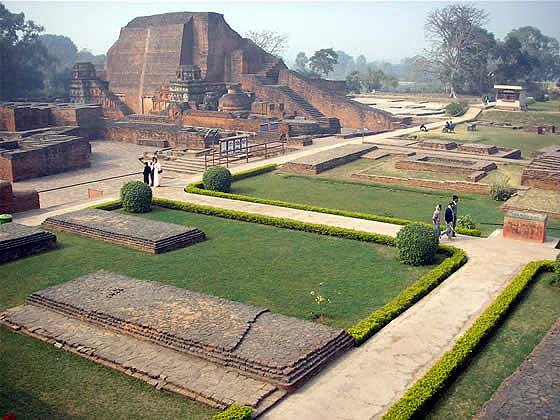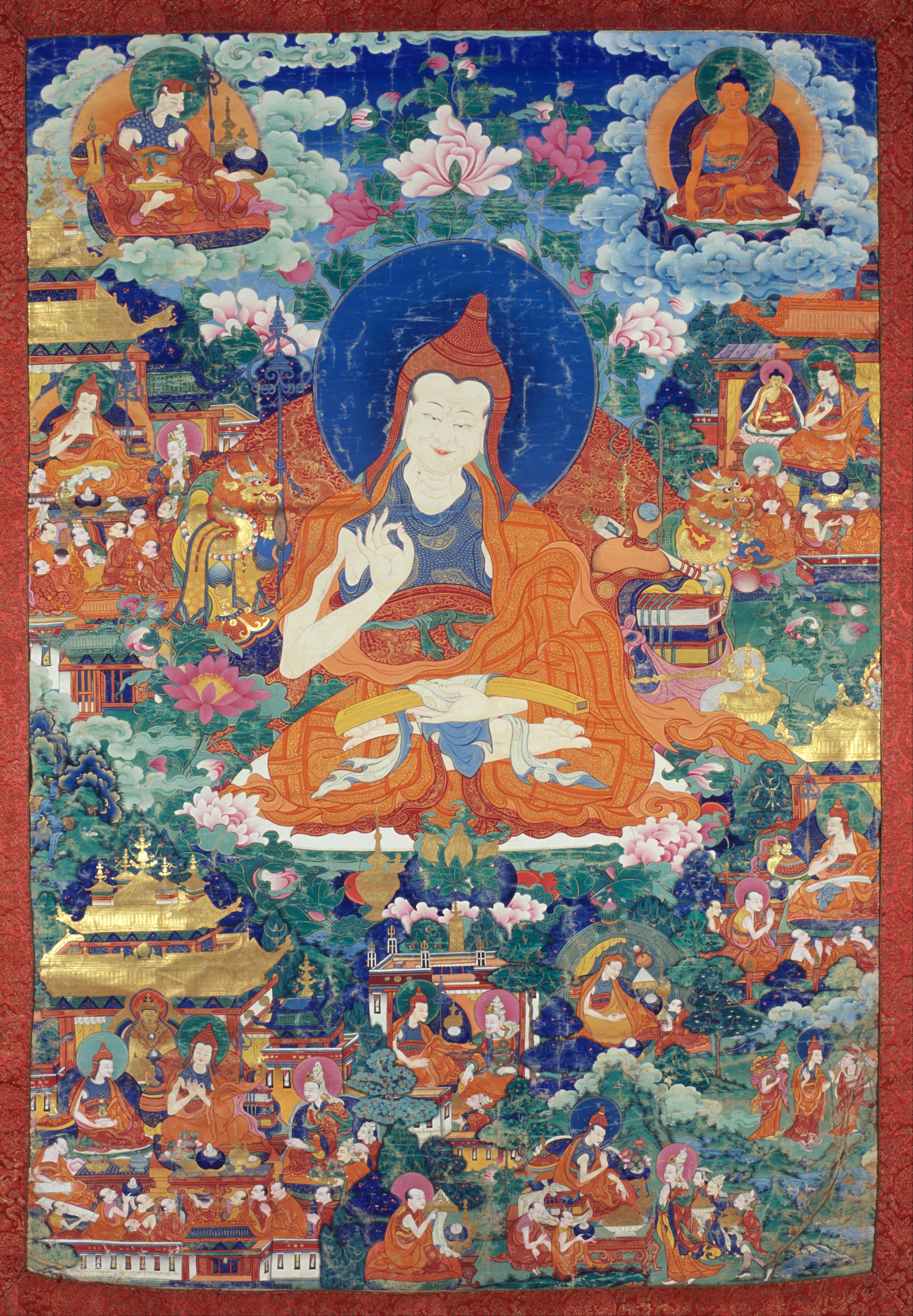|
Yogacara
Yogachara (, IAST: ') is an influential tradition of Buddhist philosophy and psychology emphasizing the study of cognition, perception, and consciousness through the interior lens of meditation, as well as philosophical reasoning (hetuvidyā). Yogachara was one of the two most influential traditions of Mahayana, Mahayana Buddhism in India, along with Madhyamaka. The compound ''Yogācāra'' literally means "practice of yoga", or "one whose practice is yoga", hence the name of the school is literally "the school of the yogins". Yogācāra was also variously termed ''Vijñānavāda'' (the doctrine of consciousness), ''Vijñaptivāda'' (the doctrine of ideas or percepts) or ''Vijñaptimātratā-vāda'' (the doctrine of 'mere representation'), which is also the name given to its major theory of mind which seeks to deconstruct how we perceive the world. There are several interpretations of this main theory: various forms of Idealism, as well as a Phenomenology (philosophy), phenomen ... [...More Info...] [...Related Items...] OR: [Wikipedia] [Google] [Baidu] |
Madhyamaka
Madhyamaka ("middle way" or "centrism"; ; ; Tibetic languages, Tibetan: དབུ་མ་པ་ ; ''dbu ma pa''), otherwise known as Śūnyavāda ("the Śūnyatā, emptiness doctrine") and Niḥsvabhāvavāda ("the no Svabhava, ''svabhāva'' doctrine"), refers to a tradition of Buddhist philosophy and practice founded by the History of Buddhism in India, Indian Buddhist monk and philosopher Nagarjuna, Nāgārjuna ().Wynne, Alexander (2015) ''Early Buddhist Teaching as Proto-śūnyavāda.'' Journal of the Oxford Centre for Buddhist Studies, 6. pp. 213-241. The foundational text of the Mādhyamaka tradition is Nagarjuna, Nāgārjuna's ''Mūlamadhyamakakārikā'' ("Root Verses on the Middle Way"). More broadly, Madhyamaka also refers to the ultimate nature of phenomena as well as the non-conceptual realization of ultimate reality that is experienced in Buddhist meditation, meditation. Since the 4th century CE onwards, Madhyamaka philosophy had a major influence on the subsequent d ... [...More Info...] [...Related Items...] OR: [Wikipedia] [Google] [Baidu] |
Buddhist Philosophy
Buddhist philosophy is the ancient Indian Indian philosophy, philosophical system that developed within the religio-philosophical tradition of Buddhism. It comprises all the Philosophy, philosophical investigations and Buddhist logico-epistemology, systems of rational inquiry that developed among various schools of Buddhism in ancient India following the ''Parinirvana, parinirvāṇa'' of Gautama Buddha (c. 5th century BCE), as well as the further developments which followed the Silk Road transmission of Buddhism, spread of Buddhism throughout Asia. Buddhism combines both philosophical reasoning and the Buddhist meditation, practice of meditation.Siderits, Mark. Buddhism as philosophy, 2007, p. 6 The Buddhist religion presents a multitude of Buddhist paths to liberation; with the expansion of early Buddhism from ancient India to Sri Lanka and subsequently to East Asia and Southeast Asia, Buddhist thinkers have covered topics as varied as cosmology, ethics, epistemology, logic ... [...More Info...] [...Related Items...] OR: [Wikipedia] [Google] [Baidu] |
Buddhist Meditation
Buddhist meditation is the practice of meditation in Buddhism. The closest words for meditation in the classical languages of Buddhism are ''bhavana, bhāvanā'' ("mental development") and ''Dhyāna in Buddhism, jhāna/dhyāna'' (a state of meditative absorption resulting in a calm and luminous mind). Buddhists pursue meditation as part of the path toward Moksha, liberation from defilements (''Kleshas (Buddhism), kleshas'') and clinging and craving (''upādāna''), also called Bodhi, awakening, which results in the attainment of nirvana. The Indian Schools of Buddhism, Buddhist schools relied on numerous meditation techniques to attain meditative absorption, some of which remain influential in certain modern schools of Buddhism. Classic Buddhist meditations include ''anapanasati'' (mindfulness of breathing), ''Patikulamanasikara, asubha bhavana'' ("reflections on repulsiveness");Deleanu, Florin (1992)Mindfulness of Breathing in the Dhyāna Sūtras Transactions of the Internatio ... [...More Info...] [...Related Items...] OR: [Wikipedia] [Google] [Baidu] |
Mahayana
Mahāyāna ( ; , , ; ) is a term for a broad group of Buddhist traditions, Buddhist texts#Mahāyāna texts, texts, Buddhist philosophy, philosophies, and practices developed in ancient India ( onwards). It is considered one of the three main existing branches of Buddhism, the others being Theravāda and Vajrayāna.Harvey (2013), p. 189. Mahāyāna accepts the main scriptures and teachings of Early Buddhist schools, early Buddhism but also recognizes various doctrines and texts that are not accepted by Theravada Buddhism as original. These include the Mahāyāna sūtras and their emphasis on the ''bodhisattva'' path and Prajnaparamita, ''Prajñāpāramitā''. Vajrayāna or Mantra traditions are a subset of Mahāyāna which makes use of numerous Tantra, tantric methods Vajrayānists consider to help achieve Buddhahood. Mahāyāna also refers to the path of the bodhisattva striving to become a fully awakened Buddha for the benefit of all sentience, sentient beings, and is thus also ... [...More Info...] [...Related Items...] OR: [Wikipedia] [Google] [Baidu] |
Vasubandhu
Vasubandhu (; Tibetan: དབྱིག་གཉེན་ ; floruit, fl. 4th to 5th century CE) was an influential Indian bhikkhu, Buddhist monk and scholar. He was a philosopher who wrote commentary on the Abhidharma, from the perspectives of the Sarvastivada and Sautrāntika schools. After his conversion to Mahayana, Mahayana Buddhism, along with his brother, Asanga, he was also one of the main founders of the Yogacara school. Vasubandhu's ''Abhidharmakośakārikā'' ("Commentary on the Treasury of the Abhidharma") is widely used in Tibetan and East Asian Buddhism, as the major source for non-Mahayana Abhidharma philosophy. His philosophical verse works set forth the standard for the Indian Yogacara metaphysics of "appearance only" (''vijñapti-mātra''), which has been described as a form of "epistemological idealism", Phenomenology (philosophy), phenomenology and close to Immanuel Kant's transcendental idealism. Apart from this, he wrote several commentaries, works on logic, ... [...More Info...] [...Related Items...] OR: [Wikipedia] [Google] [Baidu] |
Asanga
Asaṅga (Sanskrit: असंग, , ; Romaji: ''Mujaku'') (fl. 4th century C.E.) was one of the most important spiritual figures of Mahayana Buddhism and the founder of the Yogachara school.Engle, Artemus (translator), Asanga, ''The Bodhisattva Path to Unsurpassed Enlightenment: A Complete Translation of the Bodhisattvabhumi,'' Shambhala Publications, 2016, Translator's introduction.Rahula, Walpola; Boin-Webb, Sara (translators); Asanga, ''Abhidharmasamuccaya: The Compendium of the Higher Teaching,'' Jain Publishing Company, 2015, p. xiii. Traditionally, he and his half-brother Vasubandhu are regarded as the major classical Indian Sanskrit exponents of Mahayana Abhidharma, ''Vijñanavada'' (awareness only; also called ''Vijñaptivāda'', the doctrine of ideas or percepts, and ''Vijñaptimātratā-vāda'', the doctrine of 'mere representation) thought and Mahayana teachings on the bodhisattva path. He is also traditionally considered as one of the seventeen Nalanda masters who taugh ... [...More Info...] [...Related Items...] OR: [Wikipedia] [Google] [Baidu] |
Idealism
Idealism in philosophy, also known as philosophical realism or metaphysical idealism, is the set of metaphysics, metaphysical perspectives asserting that, most fundamentally, reality is equivalent to mind, Spirit (vital essence), spirit, or consciousness; that reality is entirely a mental construct; or that ideas are the highest type of reality or have the greatest claim to being considered "real".Goldschmidt et al. 2017, p. ix. Because there are different types of idealism, it is difficult to define the term uniformly. Indian philosophy contains some of the first defenses of idealism, such as in Vedanta and in Shaivism, Shaiva Pratyabhijna, Pratyabhijña thought. These systems of thought argue for an all-pervading consciousness as the true nature and ground of reality. Idealism is also found in some streams of Mahayana Buddhism, such as in the Yogachara, Yogācāra school, which argued for a "mind-only" (''cittamatra'') philosophy on an analysis of subjective experience. In ... [...More Info...] [...Related Items...] OR: [Wikipedia] [Google] [Baidu] |
Tibetan Buddhism
Tibetan Buddhism is a form of Buddhism practiced in Tibet, Bhutan and Mongolia. It also has a sizable number of adherents in the areas surrounding the Himalayas, including the Indian regions of Ladakh, Gorkhaland Territorial Administration, Darjeeling, Sikkim, and Arunachal Pradesh, as well as in Nepal. Smaller groups of practitioners can be found in Central Asia, some regions of China such as Northeast China, Xinjiang, Inner Mongolia and some regions of Russia, such as Tuva, Buryatia, and Kalmykia. Tibetan Buddhism evolved as a form of Mahayana, Mahāyāna Buddhism stemming from the latest stages of Indian Buddhism (which included many Vajrayana, Vajrayāna elements). It thus preserves many Indian Buddhist Tantra, tantric practices of the Gupta Empire, post-Gupta Medieval India, early medieval period (500–1200 CE), along with numerous native Tibetan developments. In the pre-modern era, Tibetan Buddhism spread outside of Tibet primarily due to the influence of the Mongol Emp ... [...More Info...] [...Related Items...] OR: [Wikipedia] [Google] [Baidu] |
Yoga
Yoga (UK: , US: ; 'yoga' ; ) is a group of physical, mental, and spiritual practices or disciplines that originated with its own philosophy in ancient India, aimed at controlling body and mind to attain various salvation goals, as practiced in the Hindu, Jain, and Buddhist Buddhism, also known as Buddhadharma and Dharmavinaya, is an Indian religion and List of philosophies, philosophical tradition based on Pre-sectarian Buddhism, teachings attributed to the Buddha, a wandering teacher who lived in the 6th or ... traditions. Yoga may have pre-Vedic period, Vedic origins, but is first attested in the early first millennium BCE. It developed as various traditions in the eastern Ganges basin drew from a common body of practices, including Vedas, Vedic elements. Yoga-like practices are mentioned in the ''Rigveda'' and a number of early Upanishads, but systematic yoga concepts emerge during the fifth and sixth centuries BCE in ancient India's sannyasa, ascetic and ... [...More Info...] [...Related Items...] OR: [Wikipedia] [Google] [Baidu] |
Śāntarakṣita
(Sanskrit: शान्तरक्षित; , 725–788),stanford.eduŚāntarakṣita (Stanford Encyclopedia of Philosophy)/ref> whose name translates into English as "protected by the One who is at peace" was an important and influential Indian Buddhist philosopher, particularly for the Tibetan Buddhist tradition. Śāntarakṣita was a philosopher of the Madhyamaka school who studied at Nalanda monastery under Jñānagarbha, and became the founder of Samye, the first Buddhist monastery in Tibet. Śāntarakṣita defended a synthetic philosophy which combined Madhyamaka, Yogācāra and the logico-epistemology of Dharmakirti into a novel Madhyamaka philosophical system.Blumenthal (2018) This philosophical approach is known as ''Yogācāra-Mādhyamika'' or ''Yogācāra-Svatantrika-Mādhyamika'' in Tibetan Buddhism. Unlike other Madhyamaka philosophers, Śāntarakṣita accepted Yogācāra doctrines like mind-only (''cittamatra'') and self-reflective awareness (''svasamveda ... [...More Info...] [...Related Items...] OR: [Wikipedia] [Google] [Baidu] |
Maitreya-nātha
Maitreya-nātha (c. 270–350 CE) is a name whose use was pioneered by Buddhist scholars Erich Frauwallner, Giuseppe Tucci, and Hakuju Ui to distinguish one of the three founders of the Yogācāra school of Buddhist philosophy, along with Asanga and Vasubandhu. Some scholars believe this Maitreya to be a historical person in India who authored various Yogācāra texts known as the Maitreya corpus. The traditions themselves have held that it is referring to the bodhisattva Maitreya, the future buddha. Academic views Scholars are divided in opinion whether the name refers to a historical human teacher of Asaṅga or to the bodhisattva Maitreya. Frauwallner, Tucci and Ui proposed this as a possibility, while Eric Obermiller and Fyodor Shcherbatskoy doubted the historicity of this figure. Modern scholars argue that many of the various texts traditionally attributed to Maitreya (and supposedly revealed to Asanga) like the ''Abhisamayalankara'' and the '' Ratnagotravibhaga'' are act ... [...More Info...] [...Related Items...] OR: [Wikipedia] [Google] [Baidu] |
Abhidharma
The Abhidharma are a collection of Buddhist texts dating from the 3rd century BCE onwards, which contain detailed scholastic presentations of doctrinal material appearing in the canonical Buddhist scriptures and commentaries. It also refers to the scholastic method itself, as well as the field of knowledge that this method is said to study. Bhikkhu Bodhi calls it "an abstract and highly technical systemization of the uddhistdoctrine," which is "simultaneously a philosophy, a psychology and an ethics, all integrated into the framework of a program for liberation." According to Peter Harvey, the Abhidharma method seeks "to avoid the inexactitudes of colloquial conventional language, as is sometimes found in the Suttas, and state everything in psycho-philosophically exact language." In this sense, it is an attempt to best express the Buddhist view of " ultimate reality" (''paramārtha-satya''). There are different types of Abhidharma literature. The early canonical Abhidharma ... [...More Info...] [...Related Items...] OR: [Wikipedia] [Google] [Baidu] |










